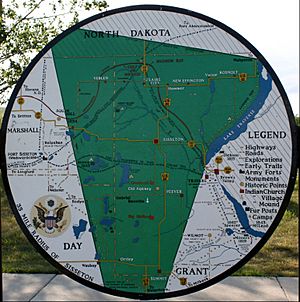Lake Traverse Indian Reservation facts for kids
Quick facts for kids
Lake Traverse Indian Reservation
|
|
|---|---|

Location in North Dakota and South Dakota
|
|
| Tribe | Sisseton Wahpeton Oyate |
| Country | United States |
| States | North Dakota South Dakota |
| Counties | Richland Sargent Codington Day Grant Marshall Roberts |
| Headquarters | Agency Village |
| Government | |
| • Body | Tribal Council |
| Population
(2017)
|
|
| • Total | 13,872 |
| Website | swo-nsn.gov |
The Lake Traverse Indian Reservation is the special homeland for the Sisseton Wahpeton Oyate tribe. This tribe is a part of the Santee Dakota group of Native Americans.
Most of this reservation is in northeastern South Dakota. Smaller parts are in southeastern North Dakota. In 2000, about 10,408 people lived here. Around one-third of them are of Native American heritage. The biggest town on the reservation is Sisseton, South Dakota. The tribe also runs its own college, the Sisseton-Wahpeton Community College.
Contents
Where is the Reservation?
The Lake Traverse Indian Reservation covers land in several counties. Over 60 percent of it is in Roberts County, South Dakota. Other parts are in Marshall, Day, Grant, and Codington counties in South Dakota. It also reaches into Sargent and Richland counties in North Dakota.
About the Sisseton Wahpeton Oyate Tribe
The Sisseton Wahpeton Oyate tribe is made up of two main groups: the Sisseton and the Wahpeton.
- The Sisseton are also known as Sinsin Tunwan, which means "Swamp Village."
- The Wahpeton are called Wahpetowan, meaning "Leaf Village."
The tribe's main office is in Agency Village, South Dakota. They speak the Dakota language. Many tribal members live on or near the reservation.
The tribe also creates many jobs. Some of the biggest employers include:
- Dakota Magic Casino
- Dakota Sioux Casino
- Dakota Western
- Dakota Crossing Grocery
- Dakota Connection Casino
- The tribal government itself
- The Bureau of Indian Affairs
How the Tribe is Governed
The Sisseton-Wahpeton Sioux Tribal Council leads the tribe. They have a constitution and bylaws that guide their government. This constitution was approved on October 16, 1946. It has been updated a few times since then.
The Tribal Council has seven members. There are also three main leaders:
- The Tribal Chairman
- The Vice Chairman
- The Tribal Secretary
These leaders help make important decisions for the tribe.
Tribal Elections
Tribal members vote for their leaders in elections.
- A primary election happens in October.
- The main election is in November.
Council members serve for four years. They can serve up to two terms in a row, which is a total of eight years. After that, they must take a break before running for the same office again. The reservation is divided into 10 election areas.
Tribal Council Meetings
The Tribal Council meets regularly. They usually meet on the first Tuesday, Wednesday, and third Thursday of each month. Sometimes, the chairman can call extra meetings if needed. For a meeting to be official, at least ten percent of eligible tribal members must be present.
Education and News
The tribe values education and communication.
- Tribal College: The Sisseton-Wahpeton Community College is located in Agency Village. It provides higher education for tribal members and others.
- Weekly Newspaper: The tribe has its own newspaper called Sota Iya Ye Yapi. This name means "smoke signals."
Important People from the Tribe
Many notable individuals have come from the Sisseton Wahpeton Oyate.
Paul War Cloud
Paul War Cloud (1930–1973) was a talented artist. He was born near Sica Hollow. He taught himself how to paint. His artwork often showed Dakota culture and traditions. You can see many of his paintings at the Tekakwitha Fine Arts Center in Sisseton. A large mural he created, called Unity Through the Great Spirit, is displayed at the Cultural Heritage Center in Pierre, South Dakota.
Gabriel Renville
Gabriel Renville (1824–1892) was the last chief of the Sissetowan and Wahpetowan tribes. He was not a hereditary chief, meaning he wasn't born into the role. Gabriel was born in Chief Sweet Corn's village on Lake Traverse. He came from the Rainville/Renville family, who were Métis. This means they had both French and Dakota ancestors. His family ran a trading post in Minnesota. The U.S. government named him chief in 1866, and the Sisseton-Wahpeton tribe agreed in 1867.
Communities on the Reservation
Here are some of the towns and communities located within the Lake Traverse Indian Reservation:
- Agency Village, South Dakota
- Claire City, South Dakota
- Goodwill, South Dakota
- Lake City, South Dakota (most of the town)
- Long Hollow, South Dakota
- New Effington, South Dakota
- Ortley, South Dakota
- Peever, South Dakota
- Rosholt, South Dakota
- Sisseton, South Dakota
- Summit, South Dakota
- Veblen, South Dakota
- Waubay, South Dakota (part of the town)


